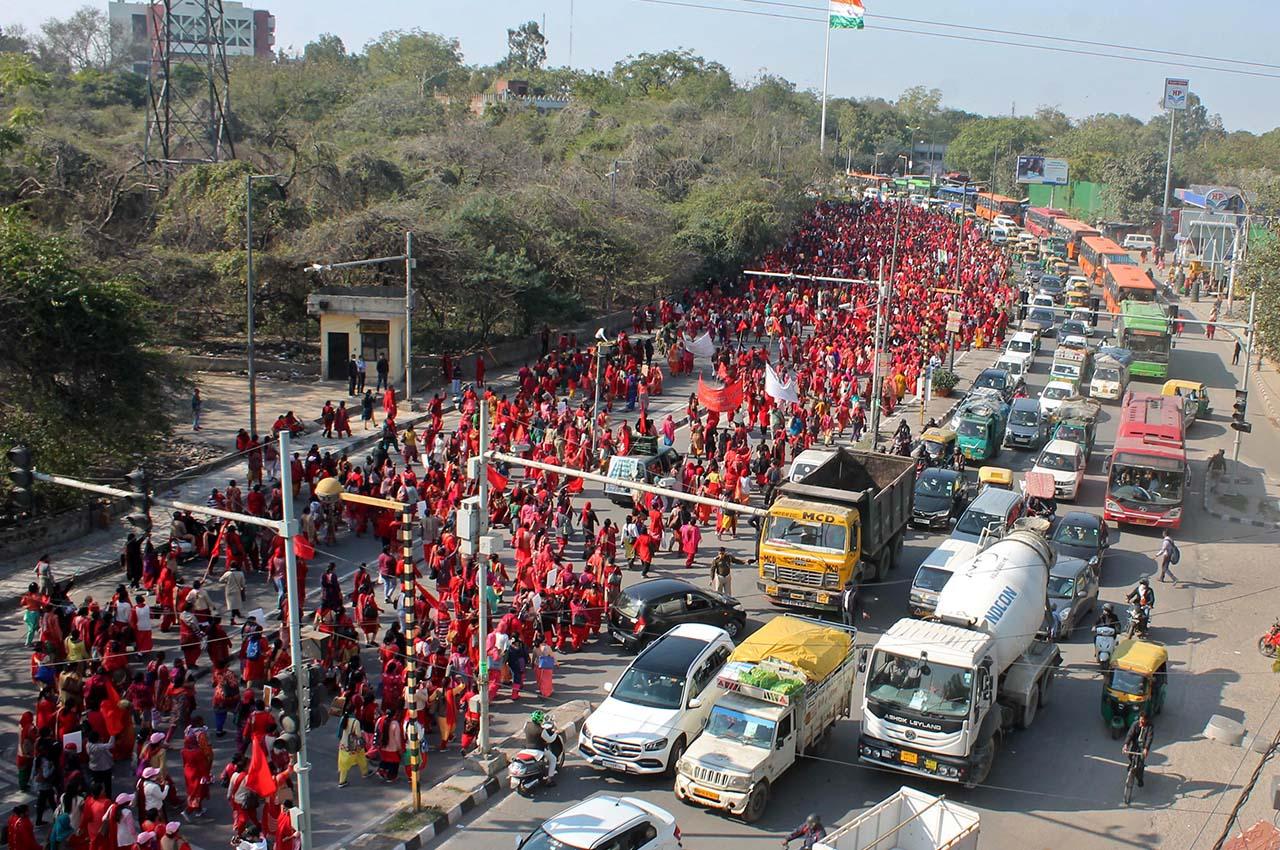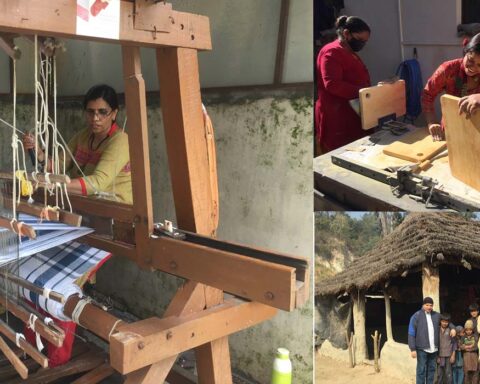Kusumlata is one of the 1.32 million Anganwadi Workers (AWW) who form the crucial last mile link in delivery of the Integrated Child Development Services (ICDS). During the deadly second wave of the Covid-19 pandemic in May 2021, she and an Anganwadi Helper (AWH) took almost two hours to cover just one kilometre due to the fortress-like barricading by police as they made their way to deliver food to children in slum clusters in South Delhi. At every checkpoint, despite being exempt from lockdown restrictions as essential services workers, they were subjected to intense questioning, bordering on harassment.
“When I came home that afternoon, my husband got very angry because I was out for work even during the peak of the wave. He was concerned about the safety of our kids and me,” says Kusumlata. A few months later, in January this year, she was among the thousands of Anganwadi workers who held an agitation near Delhi Chief Minister Arvind Kejriwal’s house, demanding better wages, retirement benefits, medical insurance and entry of non-governmental organisations in the ICDS programme. It was not the first strike by AWWs and AWHs. They have been demanding better wages and working conditions for years.
About 2.5 million AWWs and AWHs have played a pivotal role at the grassroots level in implementing the ICDS, which has brought down India’s decadal infant mortality rate between 2009 and 2019 from 47.3 to 28.3 per 1,000 live births. When the pandemic struck India, Anganwadi workers were once again in the forefront of delivering essential services to the most vulnerable sections of the population comprising children and those living in acute poverty.
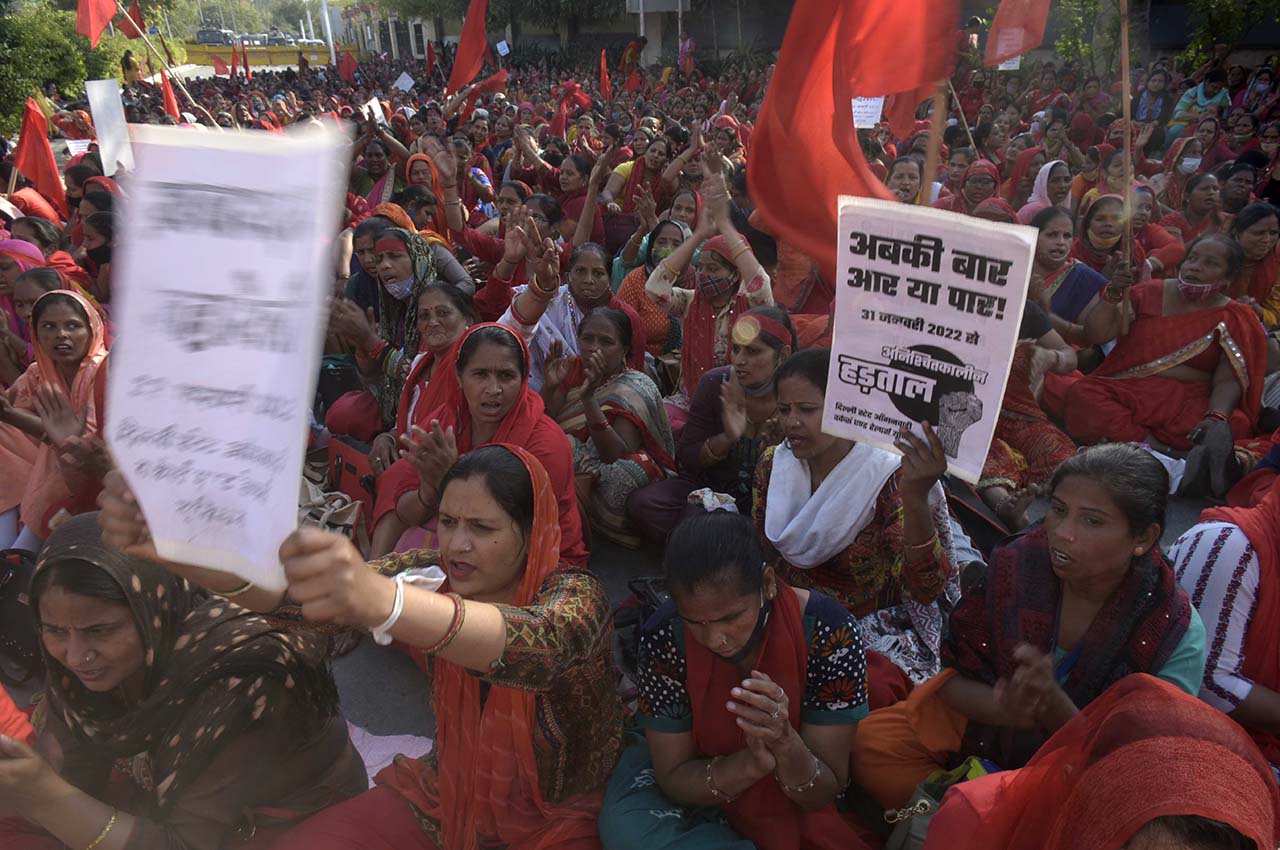
Their contribution was acknowledged by the Supreme Court in the Maniben Maganbhai Bhariya v District Development Officer Dahod & Ors case in April this year. Delivering a verdict that entitled AWWs to gratuity, Justice Abhay S. Oka observed, “The role of Anganwadi workers and Anganwadi helpers is not only at war against malnutrition, but they have played a pivotal and significant role during the Covid-19 pandemic which was the unprecedented health war faced by the nation in responding to the various challenges posed. These frontline women workers are the backbone of the ICDS.” When the responsibilities entrusted to AWWs are appraised in view of the ‘honorarium’ paid as remuneration for their services, which are officially classified as voluntary work, the extent of injustice becomes apparent.
When the pandemic struck India, Anganwadi workers were once again in the forefront of delivering essential services to the most vulnerable
Meagre pay
The central government has fixed an honorarium of ₹4,500 per month for AWWs working at Anganwadi Centres (AWCs) and ₹3,500 for those engaged at mini centres, while AWHs are paid ₹2,500 per month. Some states and Union Territories pay an additional honorarium from their local funds. After the January protest by Delhi-based AWWs, the Delhi government increased the monthly honorarium by ₹3,000 for AWWs and ₹1,500 for AWHs. In any case, the total payment for AWWs across India ranges from a paltry ₹7,000 to ₹9,000.
“The work done by Anganwadi workers and helpers was considered as ‘volunteer work’ and they were not treated as workers,” A.R. Sindhu, general secretary, All India Federation of Anganwadi Workers and Helpers (AIFAWH), told Tatsat Chronicle. “So, they were treated as volunteers. That has been the government’s definition. Thankfully, now there is Supreme Court intervention. The appointment criteria for AWWs are the same as for any other government job. They need to have minimum qualifications and they are given training for their work. Despite that, successive governments have not accepted that their duties are equivalent to those of any other government employee.”
Over the past few years, the workload of AWWs and AWHs has increased significantly but their pay has remained unchanged. Despite several recommendations by various parliamentary committees and labour unions, AWWs and AWHs do not have any legal entitlement. “From driving and organising polio or BCG vaccination campaigns to cleaning floors, from cooking food to teaching kids, from monitoring the health of children below six to distributing rations during the Covid-19 pandemic, Anganwadi workers are doing everything,” says Suman, who works at an AWC. “People ask me if this is a government job, I don’t know what to say. Sometimes relatives ask me my salary, and I just tell them that this is samaj seva (social work). For the past two years, our workload has continuously increased. During the pandemic, we were given the task of going door-to-door to check on the health of the people. Everything was shut and sometimes people did not allow us to enter the area. We put our lives at risk. Still, we had to go on a strike for better salaries and other benefits.”
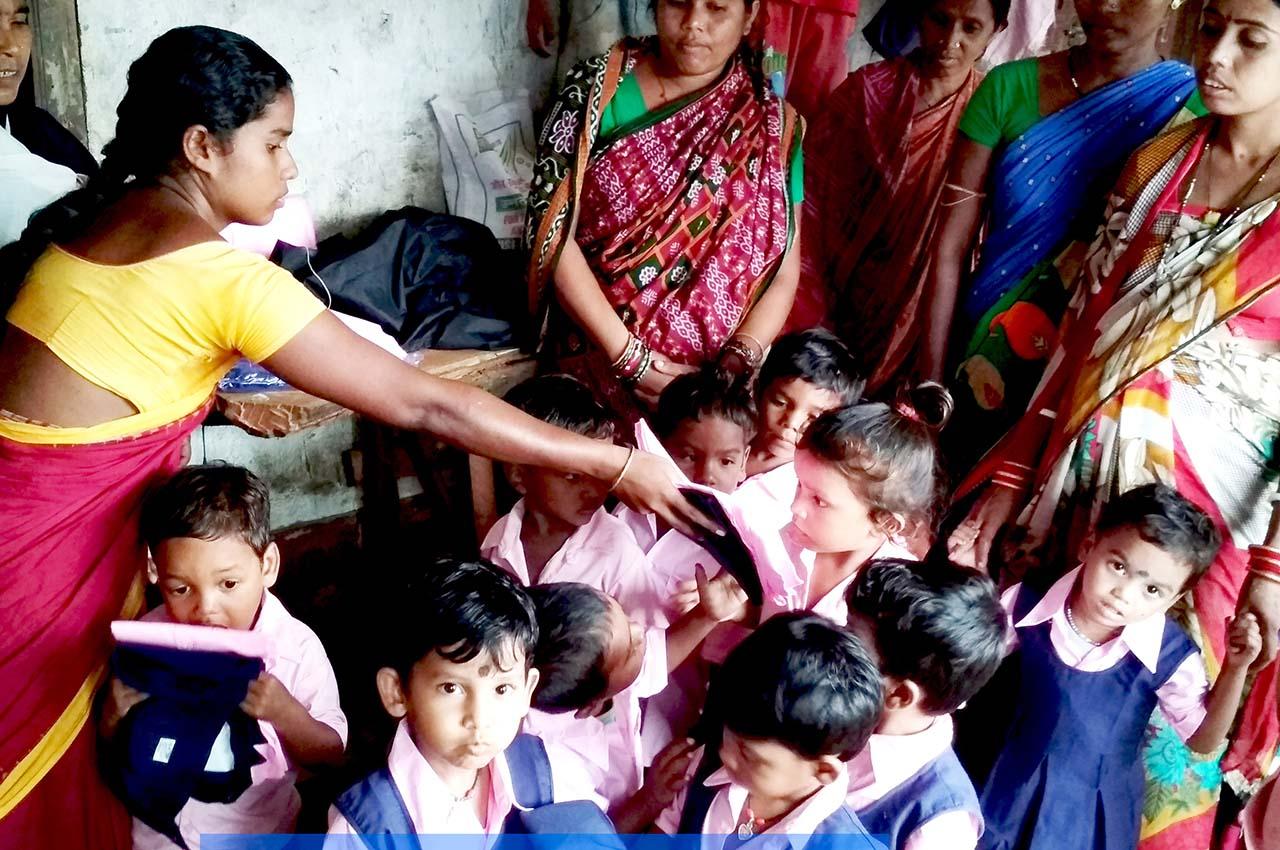
Mounting surveillance
At a time when these essential service workers are overburdened and underpaid, the government is mounting creeping surveillance on them. Last year, all the AWWs were asked to download a mobile application called Poshan Tracker on their mobile phones and upload all information about their activities and whereabouts on it within a few days. They were asked to register all such information physically as well. Despite claims by the Ministry for Women and Child Development that almost all AWWs have started using the app, the reality on the ground is quite different.
Last year, all the AWWs were asked to download a mobile application called Poshan Tracker on their mobile phones and upload all information
The mobile phones provided by the ministry to the workers were loaded with an older generation of the Android operating system, which was incompatible with the systems requirement of the new app. So these underpaid AWWs were instructed to purchase new smartphones on their own to download the Poshan Tracker. However, thousands of AWWs working in remote areas did not even own a smartphone; they possessed simple feature phones on which the app could not be used. Worse, the app was available only in English whereas thousands of AWWs can converse or work solely in their native language, especially in tribal areas. Then there is the issue of connectivity. Yet, the coercion of the ministry did not stop. Those who failed to comply with the directive were informed that their honorarium and food supplies would be reduced. It seems the developers of the app were oblivious of the ground realities.
“The workers were forced to download this app. There is also a mismatch in physical and mobile app data,” points out Sindhu. “In March last year, the ministry issued a circular that if the workers don’t download the app and put data in it, their salaries and food supply would be cut. They are claiming that the Poshan Tracker has been implemented but the problem is that last March, most of the AWCs were shut due to Covid-19 and the phones could not be collected and in some states these phones have not been provided till date.”
RESPONSIBILITIES OF ANGANWADI WORKERS
- AWWs carry out surveys within their area of operation and update the records regularly by noting occurrence of new events.
- Apart from providing health and nutrition services to children within their jurisdiction, AWWs are required to monitor growth of all children. They are also obligated to identify severely malnourished children and those in need of medical assistance.
- AWWs have a duty to monitor the growth of children in the age group of 0 to 3 years, including monitoring weight. They are responsible for maintaining a growth chart of the child’s individual growth. They must identify children who are significantly underweight and take special care of such children.
- They must make four follow-up visits every fortnight for children rehabilitated at Children Malnutrition Treatment Centres/Nutrition Rehabilitation Centres and ensure they get supplementary food at the Anganwadi centres.
- They are also required to cater to vaccination services with the help of ASHA workers and are duty-bound to undertake activities relating to health, nutrition and hygiene education.
- They are responsible for following safety and hygiene norms with respect to foodstuffs in Anganwadi centres.
- They must make home visits at least three times a week and meet children below 3 years, pregnant women and lactating mothers.
- With a view to ensure public participation, they are required to celebrate various special days.
- It is the duty of the AWWs to identify handicapped children or children with slow growth and provide referral services to them by referring them for health screening.
- AWWs are required to conduct pre-primary education activities for children of the age group of 3 to 6 years following the pre-school timetable and using the pre-school kit.
- They are required to look after the implementation and coordination of other services under various government schemes.
- They must carry out Aadhaar registration of the children attached to Anganwadi centres.
- They are required to maintain several reports, registers, records relating to beneficiaries, deaths of children, registration of births and deaths, and submit monthly or annual reports.
AWWs and AWHs are hoping that things will change following the Supreme Court judgment that came after a six-year battle in various courts across the country. In 2016, an Anganwadi Workers Union in Gujarat had filed a petition in the High Court, pleading for payment of gratuity, ranging between ₹15,000 to ₹30,000, after the state authorities rejected their demand. The single-judge bench of the court ruled in favour of the workers, but the judgment was opposed by the government in the Delhi High Court based on an earlier decision of the Supreme Court. However, the Delhi High Court did not resolve the main issue of whether the workers were eligible for gratuity; instead, it ruled that AWWs and AWHs were not eligible for minimum wages since they are not employees. Based on the legal wranglings, a division bench of the Gujarat High Court reversed the order of the single-judge bench. The April ruling by the bench of Justices Oka and Ajay Rastogi has settled the issue.
“In view of the provisions of the 2013 Act and Section 11 of the RTE Act, Anganwadi centres also perform statutory duties. Therefore, even AWWs and AWHs perform statutory duties under the said enactments. The Anganwadi centres have, thus, become an extended arm of the Government in view of the enactment of the 2013 Act and the Rules framed by the Government of Gujarat. The Anganwadi centres have been established to give effect to the obligations of the State defined under Article 47 of the Constitution. It can be safely said that the posts of AWWs and AWHs are statutory posts.”
AWWs and AWHS are hoping that things will change following the Supreme Court judgment that came after a six-year battle in various courts
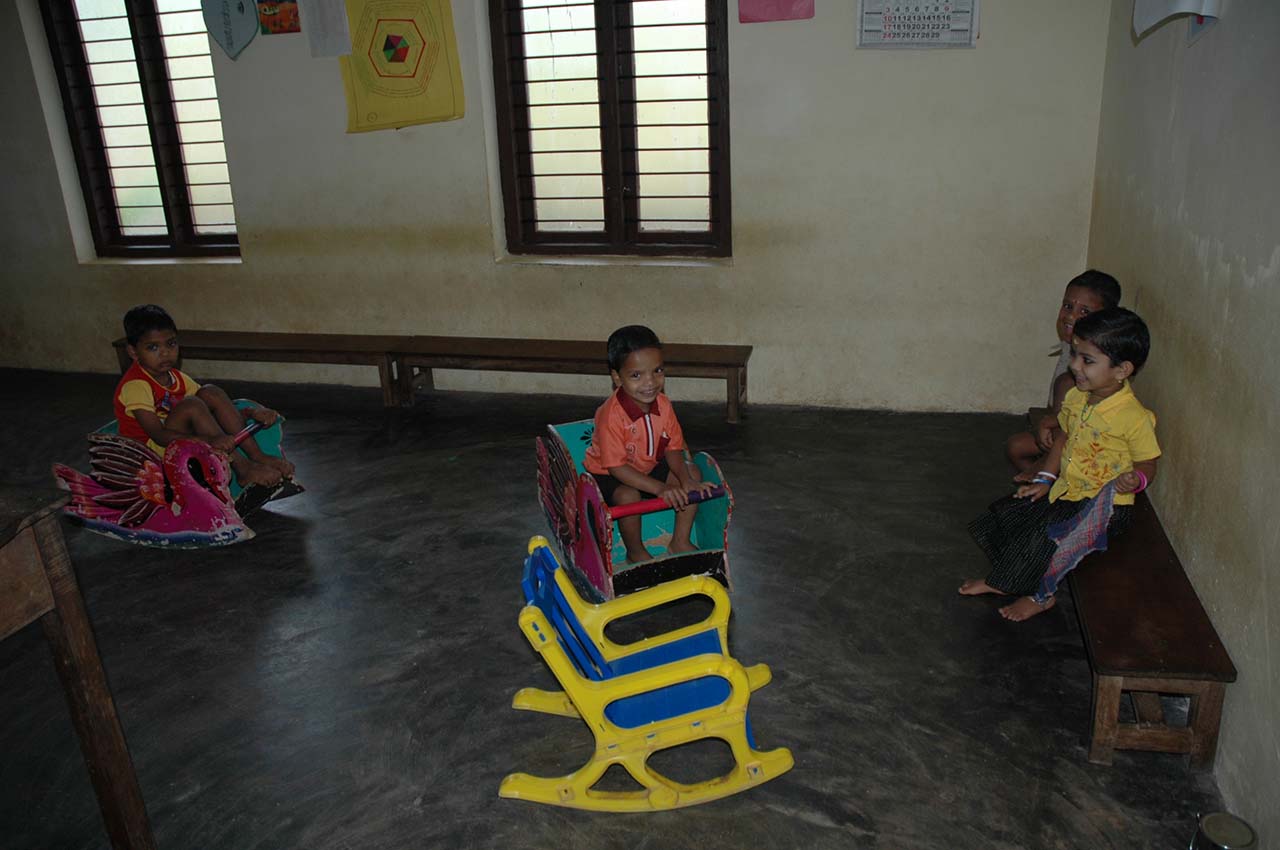
Legal consolation
However, the Supreme Court ruling will have pan-India effect. “Though this case has its genesis in Gujarat, it now has all-India ramifications,” said P.V. Surendranath, senior advocate, who argued on behalf of the Anganwadi workers in the Supreme Court. “Now, this decision can be relied upon by all Anganwadi workers across the country because it has set a judicial precedent. This is a very good development.” However, whether AWWs qualify for minimum wages is still unclear. The minimum wage per day determined by the Government of India is ₹443 and ₹533 for unskilled and semi-skilled workers, respectively, and ₹663 for skilled workers.
“The eligibility for minimum wages is still not decided. But this verdict will provide a direction for future agitations and claims. We cannot say they are eligible for minimum wages directly. But, in due course, this verdict is going to provide a legal path,” said Surendranath. The court verdict notwithstanding, the government has adopted a confrontationist stand in many other issues like deaths of Anganwadi workers due to Covid-19, contracted while delivering essential services. In April, 13 Lok Sabha MPs asked the government if it had any data in this regard. The minister for women and child development, Smriti Irani, said, “No such data is maintained in the ministry.”
Many states have accepted that AWWs lost lives due to fieldwork during the height of the pandemic. In May last year the Uttar Pradesh government decided to award financial compensation to 72 AWWs who had died due to Covid-19. “It is true that the government claims that it has no data. The government doesn’t even know how many doctors or frontline health workers died treating Covid-19 patients. But we have collected some data from some states, and we are now fighting for compensation. According to the information we have, 300 to 400 AWWs and AWHs died directly from Covid infection,” says Sindhu.

